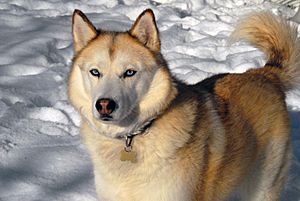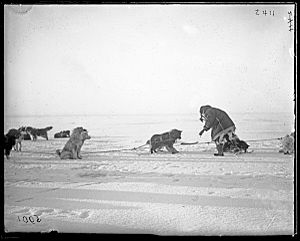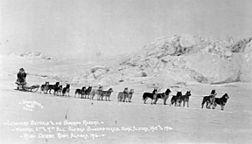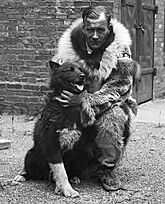Siberian Husky facts for kids

Black and white Siberian Husky
|
|||||||||||||||||||||||||||||||||
| Other names | Chukcha | ||||||||||||||||||||||||||||||||
|---|---|---|---|---|---|---|---|---|---|---|---|---|---|---|---|---|---|---|---|---|---|---|---|---|---|---|---|---|---|---|---|---|---|
| Common nicknames | Husky Sibe |
||||||||||||||||||||||||||||||||
| Origin | Siberia | ||||||||||||||||||||||||||||||||
|
|||||||||||||||||||||||||||||||||
|
|||||||||||||||||||||||||||||||||
| Domestic dog (Canis lupus familiaris) | |||||||||||||||||||||||||||||||||
The Siberian Husky is a medium-sized working sled dog breed. These dogs are part of the Spitz family. You can easily spot them by their thick double coat, pointy ears, and unique markings. They are a bit smaller than the Alaskan Malamute, which looks similar.
Siberian Huskies first came from Northeast Asia. The Chukchi people of Siberia bred them to pull sleds and be companions. They are very active, full of energy, and tough. Their ancestors lived in the super cold and harsh Arctic. A Russian fur trader named William Goosak brought them to Nome, Alaska, during the Nome Gold Rush. They were used as sled dogs for mining and traveling through tough areas. Today, many Siberian Huskies live as pets. But they are still often used as sled dogs by people who race or just enjoy mushing.
Contents
What Siberian Huskies Look Like
Their Amazing Coat
Siberian Huskies have a special double coat. It is thicker than most other dog breeds' coats. This coat has two layers. The first is a soft, wavy undercoat. The second is a longer, straight topcoat with thicker guard hairs. This coat keeps them warm in freezing Arctic winters. It also helps reflect heat in the summer. They can handle temperatures as low as -50 to -60 degrees Celsius. When they shed, the undercoat often falls out. Their thick coats need brushing every week.
Sometimes, a Husky might have a very long coat, called a "wooly" coat. This is not ideal for the breed. It does not protect as well as a normal coat. It can also make the dog get too hot during hard work. Plus, it can get tangled easily with snow and ice.
Siberian Huskies come in many different colors and patterns. They often have white paws, legs, face markings, and tail tips. Some common colors are black and white, copper-red and white, or grey and white. Pure white Huskies are also seen. A rare color is "agouti". Some have a "saddle back" pattern, where black-tipped hairs are only on their back. Their faces can have many cool masks and markings. All colors from black to pure white are allowed. However, "merle" coat patterns are not allowed by dog clubs like the American Kennel Club (AKC). This pattern can sometimes mean health problems or mixed breeding.
Their Eyes
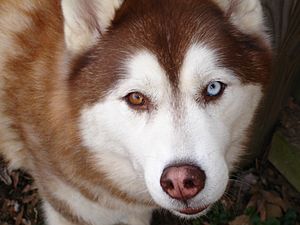
The American Kennel Club says Siberian Huskies have "almond-shaped" eyes. They are set a bit far apart and slightly slanted. Their eyes can be brown, blue, or black. It is also okay for them to have one eye of each color, or even different colors within one eye. This is called Heterochromia. These eye colors do not affect how well the dog can see.
Their Nose
Huskies that are shown in dog shows should have noses that are not too pointy or too square. The nose color matches the dog's coat. It is black for grey dogs, tan for black dogs, and liver for copper-colored dogs. White dogs might have a light tan nose. Sometimes, Huskies can have a "snow nose" or "winter nose." This means their nose color fades a bit. This is fine for show dogs.
Their Tail
Siberian Huskies have very furry tails. They often curl their tails over their faces and noses when they sleep. This helps them stay extra warm. This sleeping position is sometimes called the "Siberian Swirl." Their tail should show how they feel. It hangs low when they are relaxed. When they are excited, it curves up like a "sickle."
Their Size
Male Siberian Huskies are usually between 20 and 24 inches (51 and 61 cm) tall at the shoulder. They weigh between 45 and 60 pounds (20 and 27 kg). Females are smaller. They are usually between 19 and 23 inches (48 and 58 cm) tall and weigh between 35 and 50 pounds (16 and 23 kg). People in Nome used to call them "Siberian Rats." This was because they were smaller than the 75- to 85-pound Alaskan Malamutes.
Siberian Husky Behavior
Huskies usually howl instead of barking. They are known as "escape artists." This means they can be very good at getting out of places. They might dig under fences, chew through them, or even jump over them.
The Chukchi people raised Siberian Huskies as part of their families. Because of this, Huskies can usually be trusted with children. The ASPCA says they are good with kids. Huskies have a lot of energy, especially indoors. They need plenty of exercise. Without proper care, they can become destructive.
Siberian Huskies have a strong instinct to hunt. This is because the Chukchi let them roam free in the summer. The dogs would hunt in packs for wild cats, birds, and squirrels. But with training, they can learn to get along with other small animals. They only returned to the Chukchi villages when snow came and food was hard to find. Their hunting instincts are still strong today.
It is a good idea to have a 6-foot (1.8 m) fence for a pet Husky. Some have even jumped over 8-foot (2.4 m) fences! Electric pet fences might not work for them. They need to be around people and other dogs often. Their need to feel like part of a pack is very strong.
Siberian Huskies are friendly and gentle dogs. They are not good guard dogs. They usually do not show aggression towards humans. Also, they can be quite independent. This makes them less suitable as service dogs. Trying to teach a Husky to be aggressive can cause them mental problems. It can even be dangerous for the owner. Huskies are smart, but they can be stubborn. This is because they are independent, impulsive, and sometimes do not pay attention. It is best to start training them when they are young to help them learn to obey.
A dog psychologist named Stanley Coren ranked Siberian Huskies 77th out of 138 breeds for their intelligence. However, his ranking mainly looked at how well dogs follow commands. Huskies are sled dogs, and they often make their own decisions in bad weather. This uses different kinds of intelligence, like instinct and adapting to situations, much more.
Siberian Husky Health
Siberian Huskies usually live for 12 to 14 years. Most health problems in this breed are genetic. These can include seizures and eye problems. Eye issues can be juvenile cataracts, corneal dystrophy, canine glaucoma, and progressive retinal atrophy. Hip dysplasia is not common in Huskies. But like many medium or large dogs, it can happen. The Orthopedic Foundation for Animals ranks Huskies very low for hip dysplasia risk. Only about two percent of tested Huskies show signs of it.
Huskies used for sled racing might also get other health issues. These include stomach problems, bronchitis (sometimes called "ski asthma"), and stomach ulcers.
Most modern Siberian Huskies in the US come from dogs brought from Siberia in the 1930s. Many are also descendants of Leonhard Seppala’s dogs, especially Togo. Because there were only a few original dogs, some worry about a "founder effect." This means there is less genetic variety, which could lead to more health issues.
History of the Siberian Husky
The Chukchi people of the Chukchi Peninsula in eastern Siberia first developed the Siberian Husky. They were brought to Nome, Alaska, in 1908. Here, they worked as sled dogs and were later used for sled dog racing. In 2015, a DNA study showed that the Siberian Husky, Alaskan Malamute, and Alaskan husky are closely related. They are also linked to Chukotka sled dogs from Siberia. Siberian Huskies have a genetic link to old East Siberian dogs and ancient Lake Baikal dogs. Their family line goes back over 9,500 years.
From the 1890s to the 1930s, Chukotka sled dogs were brought to Alaska. They helped gold miners travel to the Yukon during the Klondike Gold Rush. At that time, people called dogs used by Arctic people "husky dogs." This name came from a word like "Huskemaw," which was used for native Arctic people. Canadian and American settlers did not know much about Russian geography. So, they called the dogs from Chukotka "Siberian huskies" because Chukotka is part of Siberia.
In 1930, dogs could no longer be exported from Siberia. That same year, the American Kennel Club officially recognized the Siberian Husky. Nine years later, the breed was first registered in Canada. The United Kennel Club recognized them in 1938 as the "Arctic Husky." They changed the name to Siberian Husky in 1991. Leonhard Seppala was a famous breeder of Siberian sled dogs. He had a kennel in Alaska before moving to New England. There, he partnered with Elizabeth Ricker. They owned the Poland Springs kennel and raced their dogs. The kennel was sold in 1931 when Seppala went back to Alaska.
In 1933, Navy Rear Admiral Richard E. Byrd took about 50 Siberian Huskies on an expedition. He wanted to travel around the 16,000-mile coast of Antarctica. Many of these dogs were trained at Chinook Kennels in New Hampshire. This historic trip, called Operation Highjump, showed how valuable the Siberian Husky was. They were praised for their size and speed. Siberian Huskies also helped the United States Army during World War II. They were part of the Arctic Search and Rescue Unit. Their popularity continued into the 21st century. They were ranked 16th among American Kennel Club registered dogs in 2012, and 14th in 2013.
The Great Race of Mercy: 1925 Serum Run to Nome
On February 3, 1925, Gunnar Kaasen was the last musher in the 1925 serum run to Nome. He delivered diphtheria medicine over 600 miles to Nome. This was a team effort by many sled dog teams and mushers. Leonhard Seppala and his lead dog Togo covered the longest and most dangerous part of the run. This event is shown in the 2019 movie Togo. It is also partly shown in the 1995 animated movie Balto. Gunnar Kaasen's lead dog was named Balto. However, in the movie, Balto was shown as a wolf-dog, not a pure Husky. A bronze statue of Balto was put up in Central Park in New York City. The plaque on it says:
Dedicated to the indomitable spirit of the sled dogs that relayed antitoxin six hundred miles over rough ice, across treacherous waters, through Arctic blizzards from Nenana to the relief of stricken Nome in the winter of 1925. Endurance · Fidelity · Intelligence
Siberian Huskies became very popular because of the "Great Race of Mercy." This was the 1925 serum run to Nome, featuring Balto and Togo. Balto is more famous because he delivered the medicine to Nome. He ran the final 53-mile part. But Togo made the longest run of the relay. He guided his musher Leonhard Seppala on a 261-mile journey. This included crossing the dangerous Norton Sound. Togo became an important dog for the Siberian Husky breed through his puppies.
Fun Facts About Huskies
- Huskies were used a lot by the British Antarctic Survey in Antarctica from 1945 to 1994. There is a bronze statue in Cambridge, England, to honor all of their dog teams.
- Huskies are very popular pets. But they need a lot of physical and mental activity. Because of this, many are given up to shelters. New owners sometimes do not research them enough and find they cannot care for them.
- Sled dogs bred by the Chukchi tribes were thought to be gone. But in 2006, Benedict Allen reported they still exist after visiting the region. He said the Chukchi chose dogs for being obedient, tough, friendly, and a good size for families.
- Humans use Huskies in sled-dog racing. Huskies are known for their fast pulling style.
- Many Huskies, especially Siberian Huskies, are "working dogs." This means they have high energy.
- Huskies are also kept as pets. Groups work to find new homes for retired racing dogs and adventure dogs.
Fun Activities for Huskies
Exercise is super important for Huskies. It helps them stay healthy and happy. It also helps build a strong bond between the owner and dog. Many owners now have Huskies as pets in places where sledding is not possible. So, other fun activities have been found for them.
- Rally Obedience: Owners guide their dogs through a course of exercises. There are usually 10 to 20 signs on the course. These signs tell the dog and owner what commands or tricks to do.
- Agility Training: This is a fast obstacle course that needs speed and focus. Dogs race against the clock to finish the course correctly.
- Skijoring: This is like sled pulling, but the owner is on skis. The dog pulls the owner using a rope connected between them.
- Dog hiking: This is a great choice for owners who live near trails. The owner and dog walk together on trails in nature. This activity helps both get exercise without using the Husky's strong pulling instinct. Some companies make special hiking gear for dogs. Dogs can carry their own water, food, and bowls.
- Carting: Also called dryland mushing or sulky driving. This is a city version of dog sledding. The dog pulls a cart that can carry supplies or a person. This is a good way to use a dog's natural urge to pull. These carts can be bought or made at home.
- Bikejoring: In this activity, the owner rides a bike with their dog attached. A harness keeps both the dog and owner safe. The dog or a team of dogs can pull the biker.
Images for kids
See also
 In Spanish: Husky siberiano para niños
In Spanish: Husky siberiano para niños


